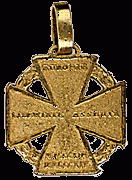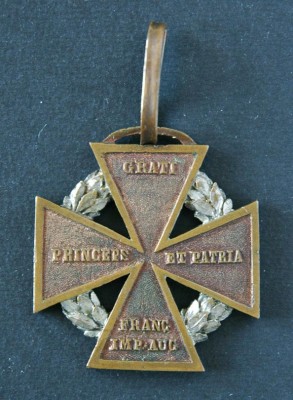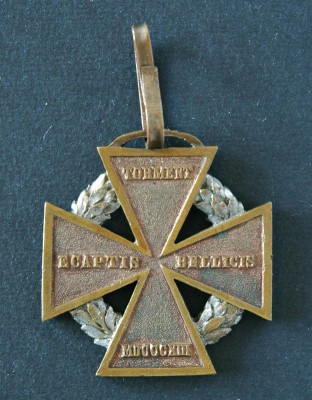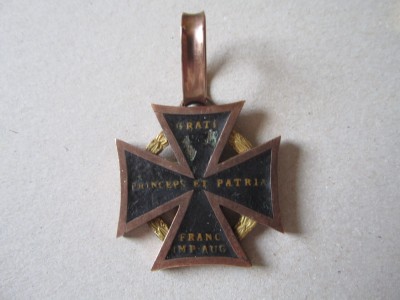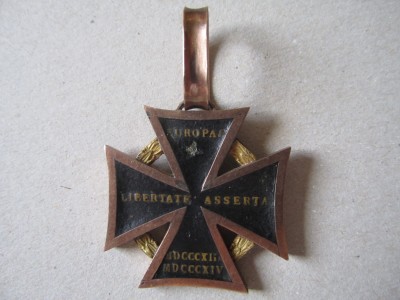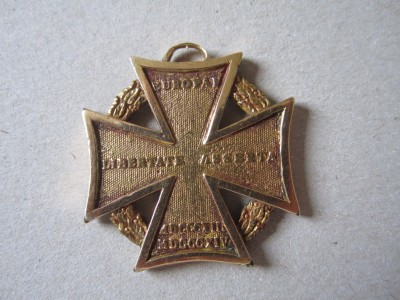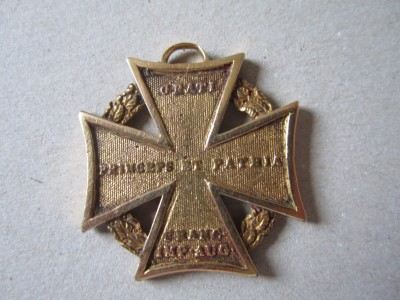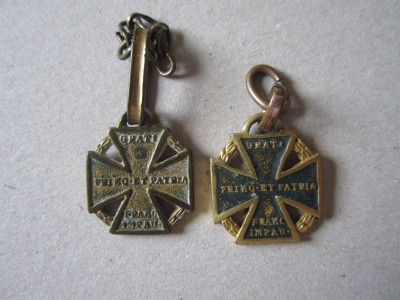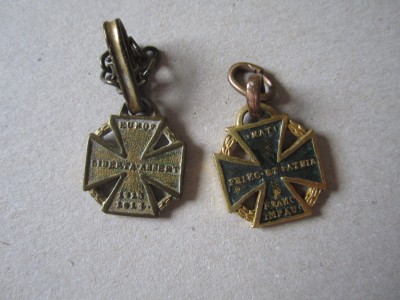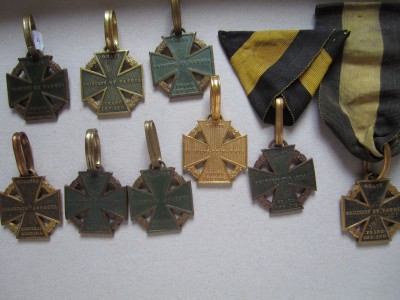| Název: Name: | Armádní kříž 1813/14 | Army Cross 1813/14 |
| Název v originále: Original Name: | Armeekreuz 1813/14 | |
| Datum vzniku: Date of Establishment: | 31.05.1814 | |
| Datum zániku: Date of Termination: | DD.MM.1918 | |
| Struktura: Structure: | - | - |
| Poznámka: Note: | - | - |
| Zdroje: Sources: | Procházka, Roman von: Österreichisches Ordenshandbuch, München 1974 | |
Armádní kříž 1813/14
Issued by Emperor Francis I in 1814 to award soldiers for their participation in the 1813-1814 campaign. In fact, the first orders were not awarded until 1815.
The order is usually called the "Cross of Cannon", as its specimens were made from captured French cannons. It is sometimes also possible to encounter the misnomer "Leipzig Cross" after the decisive battle of 1813.
The significance of this order lies in the fact that it was the first ever decoration awarded to all soldiers of the Imperial-Royal Army, regardless of rank.
The cross was originally designed in three sizes (several examples exist), but eventually only the small type with a green enamelled reverse was produced and awarded.
One large gilt specimen decorated with a laurel wreath was made for the winner from Leipzig, Field Marshal Prince of Schwarzenberg. Originally it was to be worn on a ribbon around the neck. This unique specimen is in the Military History Museum in Vienna.
Up to 200,000 of this cross are believed to have been issued, but only a few thousand have survived.
The cross was worn suspended from an elongated and deepened hanging ring in yellow and black ribbon in shades after J. Harnisch. Many individual modifications of the cross have been made over time and the colours of the ribbon have been subject to many variations (especially the light shade ranging from yellow to gold). The picture shows the standard cross with a deepened hanging ring and contemporary ribbon.
Ribbon: a yellow-gold stripe between two black ones, all of the same width.
Size: the small bronze cross awarded was 27 mm; the large cross not awarded was 45 mm and the medium cross 39 mm.
Obverse: on the face of the bronze cross, surrounded by a gold wreath, there is an inscription on its arms: 'GRATI / PRINCEPS ET PATRIA / FRANC. / IMP. AUG.'.
Reverse: five lines of inscription: 'EUROPAE / LIBERTATAE ASSERTA / MDCCCXIII / MDCCCXIV'.
Adapted and freely translated from https://www.antiquesatoz.com/napoleon/ausnapms.htm
The original design of the order, which differed from the later officially published type, was designed by J. Harnisch. It was 39 mm tall and narrower with the arms joined in the middle. The inscription on the obverse was identical to that on the issued type, but the inscription on the reverse differed: 'TORMENT / E CAPTIS BELLICUS / MDCCCXIII'. The date 1813 suggests that the original intention to issue the cross for 1813 only was later extended to the whole campaign 1813-1814. Several examples of this cross have survived.
Adapted and freely translated from https://www.antiquesatoz.com/napoleon/ausnapms.htm
As one might expect, in a heavily socially divided country like the Habsburg Monarchy, many officers refused to wear the same order as common soldiers. For this reason, three sizes were originally proposed. Probably modelled on Field Marshal Schwarzenberg's golden cross, officers had their crosses gilded, usually after the green enamel had been removed. Less commonly, they were adapted from gold or heavily gilded bronze. Sometimes officers had their initials or full name, rank or unit name engraved on the ends of the arms of the cross. The hinge often consisted of a variety of oval gold eyes. All officers' crosses are very rare, especially the examples with engraved names. Since these crosses were not official, many collectors do not pay attention to them (or at least undervalue them), but others value them highly. The specimen shown is a heavily gilded adaptation with a gold hanging eye.
Adapted and freely translated from: https://www.antiquesatoz.com/napoleon/ausnapms.htm
Criminal offences which resulted in loss of military honour, as well as the punishment of fortress labour and fortress imprisonment, were grounds for deprivation of the cross, according to the order of 12 May 1815 (M. 1762). This was confirmed by the Court Martial Council on 9.3.1816 (H.380), with the explanation that the removal of the cross was a consequence of any loss of honour pronounced by the sentence; furthermore, that the imposition of the sentence of imprisonment in the fortress entailed the removal of the cross even if the soldier had not been expressly deprived of his honour, provided, however, that the nature of his crime was, according to the law, honour-depriving.
If, however, his crime was not of that nature, the soldier was entitled to have the cross returned to him after serving his sentence. If, because of his physical constitution, the offender was given the punishment of hard labour instead of corporal punishment, there was no loss of the cross attached to the punishment, and he was entitled to have the cross returned to him after serving his sentence.
source:
Milan Hodík, Pavel Landa: Švejk - fiction and facts; Naše vojsko s.r.o. Prague 2006, ISBN 80-206-0814-1
To refresh your memory:
The Army Cross of 1813-14 was instituted by Emperor Francis I on 13 May 1814 as a commemorative decoration for soldiers who took part in field campaigns against the forces of the French Emperor Napoleon in the fateful engagements of the Napoleonic Wars. The decoration was intended for all, as a token of thanks and appreciation to the brave defenders of the homeland, both as a wearable decoration and in gratitude to the monarch.
The cross is stamped from the metal of captured cannons and has a diameter of 27 mm. The cross is squat, straight-armed, the edge is raised on both sides, the central surface is finely grained, the inscriptions protrude from the surface of the cross. The grained surface is covered with green enamel, or black lacquer, or just patinated black, but we find crosses all-gold, privately finished, named on the edges, decorated and otherwise embellished.
We show some in the picture. For example, a cross which has a green enamelled surface in the form of clover leaves, another which is fretted in gold. Thus, crosses come in a variety of variations.
The first, quite original crosses from the Vienna mint are bronze with a copper tint, the lacquer is black rather than black-green, the hanging ring 20 mm. The mint mark (a two-headed imperial eagle) is placed on the top of the hanging loop.
Most later minted crosses show considerable variation. There is always an attempt at enhancement, the gilding of the metal, the laurel wreath is in some cases removed and placed either towards the centre of the cross or, conversely, towards the end of the arms of the cross. Many owners, mostly officers, but also wealthy soldiers, have it inscribed at their expense, a citation which will be documented for several specimens.
The designer and creator of the Cannon Cross was the well-known Viennese medallist Joseph W. Harnisch (he was also the medallist of the Bohemian Cross of Nobility). It is interesting and proven that the original proposal was that the crosses would be minted in three sizes, namely 50 mm, 39 mm and small crosses in 27 mm. Herman von Heyden writes about this fact, but also F. Gottschalck.
We can rejoice that the Kaiser has decided to mint a single commemorative cross, which will become an ornament of our collections. In the attached pictures we show the types of crosses and ribbons. We will talk about the ribbons separately, because it is the ribbons to the cross that are a testament to our phaleristics, the evolution from the ribbon of the flowing ribbon to the classic triangle.
Sources used in all subsequent posts on this decoration:
The Cross of Arms was first written about by Friedrich Gottschalck in 1817-18 in his Almanac of the Orders of Chivalry. Then Herman von Heyden in his book from 1897, but also L.Trost in 1910 and finally the most detailed was Waldemar Edler von Hesse-Georg Schreiber in 1940 in a book that none of us own, thank God - it is the Wearable Decorations of the German Reich.
But, and this is important for us, Mr. Václav Měřička also drew from these authors and published the conclusions in his book: the Cannon Cross 1813-14.
It is understandable that the ribbon could not last that long and so it was changed as needed. That is why, as I have demonstrated here, there are ribbons of different widths, colour openings and shades of ribbon.
In pictures, engravings and paintings it is possible to follow the development of the cross and its wearing from a simple flowing ribbon, through a loosely folded triangle to the classic triangle as it is typical of RU orders and decorations.
After leaving the service, the soldier takes his cross with his memories to civilian life. It is both an honour and a moral obligation for him to wear this cross again on his civilian clothes. In Austrian society these soldiers (citizens) are held in high esteem. For example, they have places of honour in churches. The military Invalides take care of the socially disadvantaged families of the soldiers and take care of the upbringing and education of the children. The Fatherland has not forgotten.
After death, the cross becomes the property of the family, but in the great majority the cross is hung in the church on the "Memorial Board for the Fallen" (Gedenktafel fur die Gefallen) or just the Board of the Fallen (Gefallenentafel) here the crosses were hung in this place of honor, near the altar.
It is only the late 19th century and the loss of human decency and moral values that limits this tradition. In Germany and Austria, there is still a place of honor where the names of all the fighters for the fatherland are displayed.
A tradition that is almost unknown in the Czech lands. The image of the Cannon Cross appears once more on the stage of history in 1916. It is Charles's soldier's cross and, in fact, the end of the power.
Folded inscription ...GRATI PRIMCEPS ET PATRIA FEANC.IMP.AUG. (in two lines on the surface of the lower arm.
REVERSE: EUROPAE LIBERTATE ASSERTA MDCCCXIII/MDCCCXIV.
Translated by Grateful Sovereign and Country, Emperor Francis-Europe's freedom secured 1813/1814
A simple motto that clearly defined the meaning of the person of the decorated warrior. Therefore, it was also an honour that this simple cross was an ornament on the uniform of the generalship and was worn by the common citizen, who often lived in poor circumstances. It is found, for example, on all official portraits of Marshal Josef Radetzky, who is adorned with his cross from 1813-14.
In this particular example, we see that the Marshal's cross on his chest is already folded into a loose triangle, which is decorative on his uniform. This custom is slowly becoming a fashion "hit" and so the loosely folded cross also appears on the uniforms of soldiers and veterans.
Another cross that is available to a wide range of soldiers is the Military Service Cross on the familiar yellow and black ribbon, which is reminiscent of the ribbon of the famous Cross of Cannon, and so this decoration also appears more and more often on the first volitional, folded ribbon, but later it is the ribbons folded into a classic triangle.
The laurel wreath is preserved between the arms of the cross.
The ribbon hinge is interesting. The hanging arch is again gilded, is more delicately made in contrast to the original crosses, and has two small wire rings wired into it.
These rings then run through the actual hanging ring, which is 15 mm in diameter. The sling thus modified was clearly adapted to be worn on a lanyard. It appears that such a cross was adapted by a wearer from Germany, where draught ribbons were used.
This interesting modification of the hanging method shows that the initiative and inventiveness of the wearers and manufacturers was considerable and only proves how often and arbitrarily and against the rules they modified the wearer's decorations.
The reverse side, however, bears a different inscription. On the face of the upper arm it reads TORMENT, on the face of the horizontal arms E.CARTIS BELLICIS and on the face of the lower arm MDCCCXIII. Translated - Grateful Sovereign and Country. Franz the Emperor of Austria et seq: From captured enemy works. 1813. The ribbon corresponds to the ribbon of the Cross of Cannon.
The fact that only the year 1813 is placed on the back of the cross shows that the design had been prepared earlier, waiting for the right time, the great victory and defeat of Napoleon. The size of the cross also varies:
The cross size is 27 mm
Cross size 39 mm
Cross size 50 mm
This information was first published by
Herman von Heyen in his book: Ehrenzeichen Deutschland und Oesterreichs-Ungars published in 1897. But even Friedrich Gottschalck in his Almanach Die Deutschen Ritterorden in 1817 stated that it was intended to mint the commemorative medals of 1813-14 in a total of 100,000 pieces, of which 4,000 large, 6,000 medium and 90,000 small decorations (crosses) were to be produced. We know, however, that only one single Grand Army Cross of 1813-14 was issued, 45 mm in diameter, which was awarded in gold to the Commander-in-Chief of the Czech Army, Field Marshal Karl Filip Prince Schwarzenberg, and a small cross to all other combatants of this army, where the name Czech already predestines this cross to the history and modern Czech Army of today.
The design cross described here was originally in the collection of Dr. Julius. In 1959 it was purchased by Prof. Dr. Giovanni Fattovich for his collection. Mr. Václav Měřička, a friend of Professor Fattovich, personally saw and described this design piece in his book Orden und Ehrenzeichen der Oestrreichichs-Ungarischen Monarchie on page 205.
This post has not been translated to English yet. Please use the TRANSLATE button above to see machine translation of this post.
I′m a new member of this forum and a collector of Imperial Austrian Orders & Decorations.
I would like to add some data to this interesting discussion, posting the pictures of Harnisch′s prototype of the Cannon Cross, once in the v. Heyden, then Julius collection.
Best wishes,
Elmar Lang
Thanks to Mr. Ivan Chudý we can imagine one such beautiful little thing. It is a miniature pin of a soldier of our army who was involved in the war against Napoleon. In this case, we can successfully speculate that it is an Austrian non-commissioned officer and we can also quite accurately delineate the award of the St. George Cross with the number: 25 737
Russian literature assigns the numbering of the St. George Crosses of 1812-1815 from:
- 22 894 - 71 781 ( our cross is numbered 25 737).
The miniature crosses are mounted on a silver, decorated clasp as we know this arrangement from around 1820. The clasp is backed by an older, but probably not original, ribbon of the Cross or Order of St George. It is almost certain that the original ribbon was a composite of the ribbon of the 'Cannon Cross and the Cross of St George'.
l. A miniature of the "Cross of the Cannon" :
- The cross is custom made and gilded. The surface of the cross is enamelled with black enamel, which appears around 1820 and is also found as a fashionable element on other crosses, mostly privately made and modified by jewellers. We can conclude that this is a beautiful, classic miniature of a cross, and a fine example of a specimen that meant so much to our forefathers.
2. St. George's Cross:
- The cross, its foundation and other details are described in some detail and so just as a reminder.
The Cross was instituted as a high decoration for Russian soldiers in 1807, and only in a single class. At the time when the cross we are describing here was awarded it was not correctly called the " Order of St. George 5th degree" in the Russian army, and even a few original award decrees for soldiers of the Prussian army survive where the cross is indeed called the Order of the 5th degree. The cross that this Austrian non-commissioned officer received in joint combat with Russian troops was this so-called 5th degree cross. It is very interesting that the miniature of the St. George's Cross is carefully made according to the original cross and the exact registration number, which does not correspond to the Russian numbering, but the jeweler used the classical numbering exactly as it was used in this period. The front medallion with Saint George slaying the dragon is somewhat larger in the miniature and the figure of the knight slaying the dragon is, after all, somewhat different than on the Russian original. The Austrian jeweller modified the clasp according to the fashionable view of society around 1820-1830.
Interestingly enough, the St. George cross is numbered, but this is just a customer request. Several such miniatures can be found in German collections devoted to the Napoleonic Wars. Mr. Václav Měřička had a similar pin in his collection.
In conclusion, we can only say that this is a very nice and collectible miniature, which is a reminder of the military campaign of our great-grandfathers and their final victory over Napoleon, where the Czech names presented by Prince Schwarzenberg or the later Marshal Radetzky are a reminder of the bravery of simple soldiers from Bohemia and Moravia.
COMMENT:
This mini pin is in the collection of our Austrian colleague, who does not wish to be named, but has provided us with a picture of the decoration for which we are grateful.
To please the eye, we will show crosses from the private collection of our Austrian colleague, which he provided for the needs of www.valka:
Figure 1:
The cannon cross is jewelled with golden wider faceting. It is interesting that the jeweller probably had to cut off the laurel wreath and partially move it. All in all, it is a very nice modification underlined by the quality of the enamelling. The hanging ring is atypical, heavily gilded. Although the cross lacks the original ribbon it is an exceptional specimen. The inscriptions on the surface of the cross are clear and easy to read.
Figure 2:
Here we can talk about a classic and certainly original Cannon Cross whose only modification is gilding in fire. This is a contemporary and fashionable treatment that was used in Austria in the first half of the 19th century.
Figure 3:
The picture shows two classic miniatures one is certainly interesting for its hinge, it is possible that the hinge is from an original cross and the decoration was worn on a smaller ribbon loosely folded into a triangle.
Picture 4:
The last picture from the collection of our Austrian colleague presents us with a set of nine crosses in total, which represent phallic classics.
Thanks to Mr. Ivan Chudý for arranging and supplying the pictorial material. The images are inserted with the permission of the owner.
Diskuse
This post has not been translated to English yet. Please use the TRANSLATE button above to see machine translation of this post.
This post has not been translated to English yet. Please use the TRANSLATE button above to see machine translation of this post.
excuse me if I don′t speak or write in Czech or Slowak language...
I′m glad that you would like the pictures I′ve sent, of the Harnisch prototype of the Kanonenkreuz.
As a further information it is the same piece published by Vaclav Mericka in "Zajimavosti o delovém krizi a obcanskem krizi z let 1813 a 1814", (Drobna Plastika), page 25.
This piece, belonged to the von Heyden Collection (nr. 1009), was sold in auction (lot 860) on Oct. 19th 1898, becoming part of the Julius Collection, then auctioned on Sept. 14th-16th 1959, becoming part of the Fattovich Collection.
This same piece was published in the "Mitteilungen der Oesterreichischen Numismatischen Gesellschaft", Band XVI, Nr. 5 - 1959, pages 61-64.
Best wishes,
Elmar Lang
This is a (hopefully readable) translation, done with an internet free translator:
Dobrý den,
promiňte, když nebudou mluvit ani psát v českém jazyce nebo Slowak ... Jsem rád, že se budete chtít fotky jsem poslal z prototypu Harnischa z Kanonenkreuz.
Jako další informace je stejný kus zveřejněny Václav Měřička v "zajímavosti o delovém krizi jeden obcanskem krizi z let 1813 jeden 1814", (Drobna Plastika), str. 25. Tento kus patřil k von Heyden kolekce (č. 1009), byl prodán v dražbě ( šarže 860) dne 19. října 1898, se stanou součástí Julius kolekce, tak vydražené na 14. až 16. září 1959, se stanou součástí je Fattovich Collection.
Stejný kousek byl zveřejněn v "Mitteilungen der Oesterreichischen Numismatischen Gesellschaft", Band XVI., Nr. 5 - 1959, pages 61-64. Všechno nejlepší,
Elmar Lang
Join us
We believe that there are people with different interests and experiences who could contribute their knowledge and ideas. If you love military history and have experience in historical research, writing articles, editing text, moderating, creating images, graphics or videos, or simply have a desire to contribute to our unique system, you can join us and help us create content that will be interesting and beneficial to other readers.
Find out more